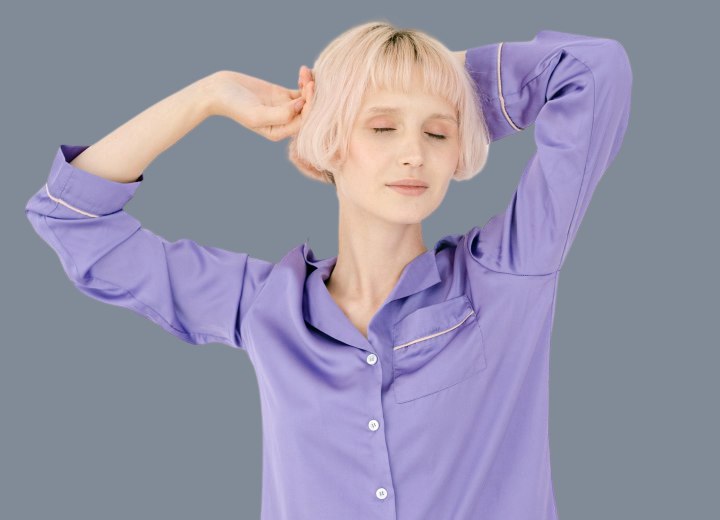Silk & Satin for Healthy Hair

It all boils down to protecting your hair as you sleep, and guess what? It can be an enjoyable experience too. Invest in quality bedding, like a silk or satin pillow and sheets, and maybe even treat yourself to some new pajamas. These simple steps can make a real difference in how your hair looks and feels. Now, let's break down why and how to protect your hair while you snooze.
First off, let's talk about why traditional cotton or linen bedding might not be the best for your hair. Cotton is rough, absorbs a lot, and can create friction. This can lead to problems, especially if you're a restless sleeper. All that rubbing against your cotton pillowcase and sheets can cause knots, damage, and split ends – not fun.
On the flip side, silk and satin bedding are much gentler on your hair. These materials are smooth and don't absorb as much, meaning less friction and better retention of your hair's natural oils and moisture. So, when you toss and turn at night, your hair will slide over the pillow and sheets more smoothly, reducing the risk of tangles and damage. The result? Shinier, healthier, and more manageable hair. Sweet dreams and beautiful hair – now that's a winning combination!

Choosing new pajamas makes sense if you typically wear them to bed, whether it's pajamas, a T-shirt, or a high-necked nightgown. If you're already using a nightgown with a low neckline and thin straps or a chemise, you're on the right track. In this case, less of your hair comes into direct contact with your skin, minimizing damaging friction.
If you haven't tried silk or satin pajamas before, now might be the perfect time. Not only are they pleasant to wear, but opting for smooth fabric adds a touch of luxury and elegance while providing an easy way to care for your hair by safeguarding it during sleep.
When people think of silk or satin pajamas, the image that often comes to mind is a collared button-down top paired with pants. Some might also envision a nightshirt with buttons, resembling a shirtdress. However, there are silk options with a round neckline, resembling a T-shirt. Wearing silk or satin pajamas doesn't mean you have to button up every night – you can choose a simpler T-shirt version for added comfort.
You probably guessed it – one of the main perks of wearing silk and satin pajamas is their smoother and gentler feel compared to traditional cotton or flannel fabrics. When you toss and turn during sleep, your hair rubs against your pajamas, causing the same kind of friction and potential damage as with your bedding. Opting for smooth and silky pajamas creates a low-friction environment, allowing your hair to glide effortlessly.
Another advantage of silk and satin pajamas is their low absorbency. Unlike cotton or some other materials, they don't soak up your hair's natural oils and moisture as much. Instead, these fabrics help retain your hair's essential oils, providing a healthier environment for your locks.
Now, let's talk about the difference between silk and satin.
Silk and satin are two popular materials for bedding and clothing, often used interchangeably. People love them for their softness, sheen, and luxurious feel. While they might seem similar, there are some key distinctions.
Silk is a natural fiber produced by silkworms. It's harvested from silkworm cocoons and spun into thread for fabric. The smooth texture of silk comes from its thin, natural fibers, providing a subtle sheen. Silk is a natural insulator, regulating body temperature to keep you cool in the summer and warm in the winter. It's also hypoallergenic, making it a great choice for those with sensitive skin or allergies.

Now, let's talk about satin. Unlike silk, satin has a more modern weaving style. It can be crafted from various materials, such as silk, polyester, and nylon. Satin's distinctive glossy finish comes from the way it's woven. The most common type is made from polyester, a synthetic fiber known for its durability and affordability. While silk can also be used, it's less common due to its higher cost.
Polyester satin, while not as insulating as silk, is still a breathable fabric that keeps you cool and comfy on warm nights. It's moisture-wicking, making it an excellent choice for those seeking a luxurious feel without the hefty price tag of silk. Plus, taking care of polyester satin is a breeze – it's a robust fabric that can handle machine washing and drying, unlike the more delicate silk.
While long hair can be stunning, it's more prone to nighttime damage compared to shorter hair. The length of your hair increases its susceptibility to damage, no matter how cautious you are.
Long hair is more likely to tangle and knot during the night. Your movements in bed can cause it to snag on the pillow, sheets, and blanket, resulting in those frustrating tangles and knots. When morning comes, untangling with a brush or comb becomes necessary, but it can strain and harm the hair shaft.
With longer hair, there's more surface area in contact with your bedding and pajamas, and you're sleeping with your back and shoulders against your hair. This increases the chances of friction, leading to damage and an overall less healthy appearance compared to someone with shorter hair.

On the flip side, short hair, like a bob or a pixie cut, is less likely to face damage while you sleep because it's less prone to tangling or rubbing against surfaces. Despite needing more frequent trims, which help prevent split ends and breakage, short hair generally has an advantage in looking healthy compared to long hair.
But even if you have short hair, a little nighttime protection goes a long way. A smooth pillowcase reduces friction, preventing damage to the hair shaft. Cotton and some other fabrics can still pose a risk to short hair. Silk and satin also help retain moisture in short hair, reducing dryness and brittleness. So, whether your hair is very short or long, it's crucial to treat it gently and provide protection while you sleep.
Ready to hit the hay?
Now that you've got your new silky-smooth bedding and pajamas, it's almost time for some beauty sleep! Before you hop into bed, take a few minutes to thoroughly brush your hair. This helps eliminate any tangles or knots from the day and spreads the natural oils from your scalp throughout your hair, keeping it moisturized and nourished as you sleep.

Steer clear of sleeping with wet hair. It can lead to significant damage and breakage, so ensure your hair is fully dry before bedtime. If sleeping with damp hair is unavoidable, consider using a silk or satin headband or bonnet for added protection and to ward off tangles.
Lastly, remember the importance of maintaining a solid hair care routine during waking hours. While sleeping on silk and satin contributes to healthy hair, using top-notch hair care products designed to nourish and shield your hair is crucial. Exercise caution with flat irons, curling irons, and hair dryers – use them correctly to avoid unnecessary damage.
©Hairfinder.com